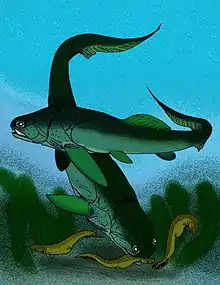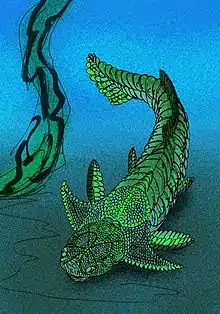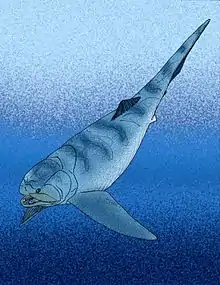Coccosteus
Coccosteus ("seed bone") is an extinct genus of arthrodire placoderm. Its fossils have been found throughout Europe and North America. The majority of these have been found in freshwater sediments, though, such a large range suggests that they may have been able to enter saltwater. The largest specimens were about 40 centimetres (16 in), although the average length was 20 to 24 centimetres (7.9 to 9.4 in).
| Coccosteus | |
|---|---|
 | |
| C. cuspidatus specimen IVPP V19322, Paleozoological Museum of China | |
| Scientific classification | |
| Kingdom: | |
| Phylum: | |
| Class: | |
| Order: | |
| Family: | |
| Genus: | Coccosteus Miller ex Agassiz, 1841 |
| Species | |
| |


Like all other arthrodires, Coccosteus had a joint between the armour of the body and skull. It also had an internal joint between its neck vertebrae and the back of the skull, allowing for the mouth to be opened even wider. Along with the longer jaws, this allowed Coccosteus to feed on fairly large prey. The up-and-down movement of the skull also allowed for more water to be pumped through the gills. Possibly, the creature supplemented its diet with organic material filtered from mud using the gills. As with all other arthrodires, Coccosteus had bony dental plates embedded in its jaws, forming a beak. The beak was kept sharp by having the edges of the dental plates grind away at each other.[1] Overall the creature looked similar to its gigantic cousin Dunkleosteus, save that its eyes were closer to the end of its snout than in its larger relative.
Species
C. cuspidatus
This is the type species, and is an important index fossil in the continental Devonian sequence of northern Scotland deposited in the Orcadian Basin. It is only present at and below the Upper Eifelian Achanarras limestone level.[2]
See also
References
- Palmer, D., ed. (1999). The Marshall Illustrated Encyclopedia of Dinosaurs and Prehistoric Animals. London: Marshall Editions. p. 32. ISBN 978-1-84028-152-1.
- Trewin, N.H.; Davison R.G. (1999). "Lake-level changes, sedimentation and faunas in a Middle Devonian basin-margin fish bed". Journal of the Geological Society. 156 (3): 535–548. Bibcode:1999JGSoc.156..535T. doi:10.1144/gsjgs.156.3.0535. Retrieved 7 July 2012.


